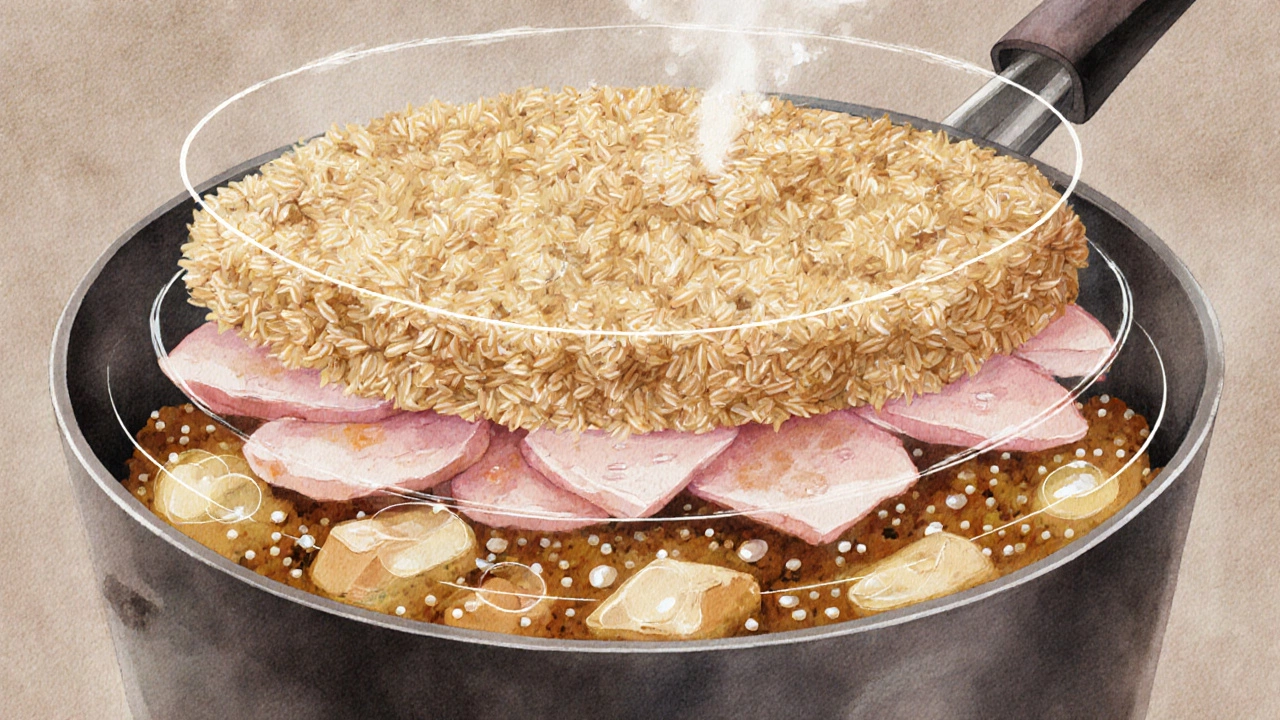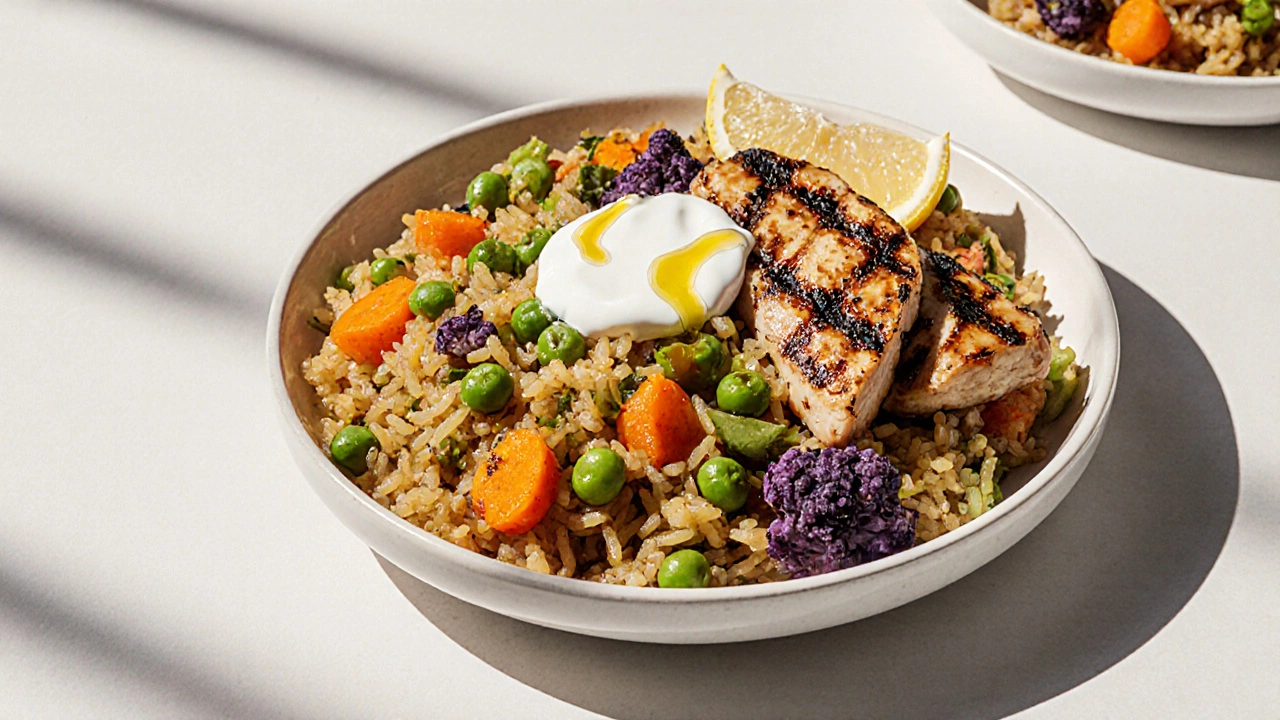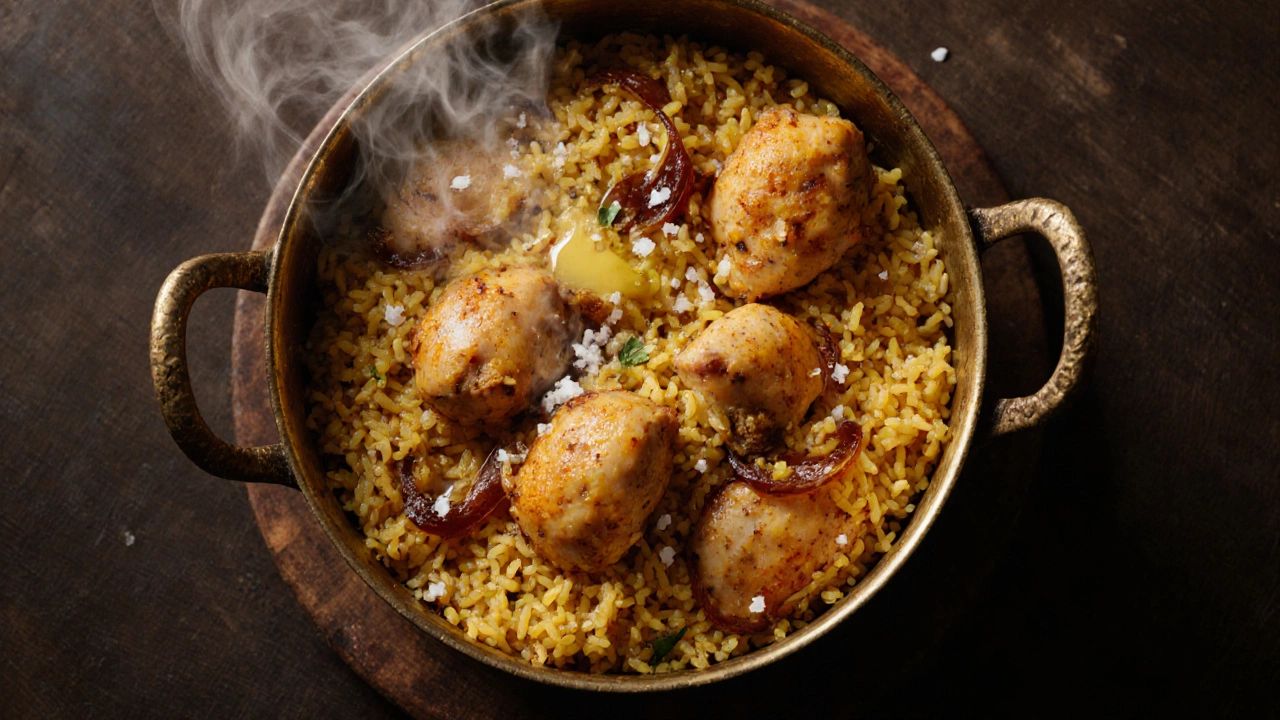Ever wondered why your favorite Biryani is a layered rice dish that mixes fragrant rice, meat or vegetables, and a burst of spices sometimes leaves you feeling sluggish? The answer isn’t magic-it's the nutrition profile. Below we break down the main culprits that make biryani a calorie‑dense, high‑fat, high‑sodium meal, and then show practical swaps that keep the flavor while cutting the health hit.
What Gives Biryani Its Signature Taste?
Traditional biryani leans on a handful of power ingredients:
- Basmati rice is a long‑grain rice prized for its aroma and fluffy texture.
- Ghee (clarified butter) adds richness and a buttery mouthfeel.
- Vegetable oil or mustard oil for sautéing onions and spices.
- Meat (chicken, lamb, or beef) or hearty vegetables that bring protein.
- A blend of spices-cumin, coriander, turmeric, cardamom, and garam masala-that creates the unmistakable aroma.
Each component boosts taste, but it also adds calories, fat, or sodium.
Calorie Load and Portion Sizes
A typical restaurant serving of chicken biryani (about 350 g) can contain 750‑900 kcal. Much of that comes from the rice itself; a cup of cooked basmati provides roughly 200 kcal, and a biryani recipe often uses 2‑3 cups of rice per pot. When you add oil, ghee, and meat, the calorie count climbs quickly.
Portion control is a common stumbling block. Because biryani is served in a single, mixed bowl, it’s easy to scoop out more than the recommended 1‑1.5 cups of rice plus a modest protein portion. Overeating not only spikes daily calorie intake but also raises blood sugar levels.
Fat Factor: Ghee, Oil, and Saturated Fat
Ghee is high in saturated fat-about 7 g per tablespoon-making it a dense source of calories (≈120 kcal). The same applies to vegetable oil, which contributes roughly 14 g of fat per tablespoon.
When a biryani recipe calls for 4‑6 tablespoons of ghee or oil, you’re adding 500‑720 kcal just from fat. High saturated‑fat intake is linked to elevated LDL cholesterol, a risk factor for heart disease.
Sodium Overload
Salt is essential for biryani’s depth of flavor, but it can quickly become excessive. A typical biryani recipe uses 2‑3 teaspoons of salt, translating to about 4,000‑6,000 mg of sodium-well above the daily recommended limit of 2,300 mg.
High sodium intake raises blood pressure, strains the kidneys, and can contribute to cardiovascular problems. Many ready‑made biryani mixes and restaurant versions add extra sodium through stock cubes and pre‑seasoned meat, pushing the numbers even higher.

Refined Carbs and Glycemic Impact
Basmati rice is technically a refined carbohydrate. Its glycemic index (GI) ranges from 50‑58 for plain basmati, but once it’s cooked with oil and spices, the GI can rise to 70‑80. That means a rapid surge in blood glucose, especially after a large serving.
Frequent spikes in blood sugar can lead to insulin resistance over time, a precursor to type 2 diabetes. Pairing biryani with a high‑protein side (like raita) helps blunt the spike, but the root issue remains the carb load.
Cholesterol Concerns
Meat‑based biryani-especially lamb or mutton-adds dietary cholesterol (≈70‑80 mg per 100 g of meat). While dietary cholesterol’s impact on blood cholesterol varies per individual, combining it with saturated fat from ghee creates a double whammy for heart‑health‑aware eaters.
If you opt for chicken breast or lean goat meat, cholesterol drops, but the saturated fat from cooking fats can still keep the overall risk elevated.
How to Lighten the Load Without Losing Flavor
Good news: you don’t have to give up biryani. Simple tweaks keep the aroma and texture while trimming calories, fat, and sodium.
- Swap white basmati for brown basmati or millet. Brown rice adds fiber, reduces the GI to the low‑50s, and contributes about 15 g of fiber per cup.
- Replace half the ghee with a splash of low‑fat yogurt or a teaspoon of olive oil. This cuts saturated fat by up to 40 %.
- Use a low‑sodium broth and cut the added salt in half. Finish with a squeeze of lemon or a pinch of chaat masala for brightness.
- Bulk up with vegetables-cauliflower, carrots, peas, and beans. They add volume, nutrients, and fiber without many calories.
- Choose lean protein: skinless chicken breast, turkey, or plant‑based alternatives like tofu or tempeh.
These adjustments can bring a typical serving down to 400‑500 kcal, with less than 10 g of saturated fat and under 1,500 mg of sodium.

Quick Checklist for a Healthier Biryani
- Use whole‑grain rice or a rice‑alternative.
- Limit ghee to 1 tablespoon; supplement with yogurt or olive oil.
- Reduce added salt; rely on spices for flavor.
- Include at least 50 % vegetables by volume.
- Serve a controlled portion (≈1 ½ cups cooked rice + protein).
Traditional vs. Healthier Biryani - Quick Comparison
| Aspect | Traditional Chicken Biryani | Healthier Version |
|---|---|---|
| Calories | ≈850 kcal | ≈440 kcal |
| Sat. Fat | ≈12 g | ≈4 g |
| Sodium | ≈5,500 mg | ≈1,200 mg |
| Fiber | ≈3 g | ≈8 g |
| Protein | ≈30 g | ≈35 g |
| Carb GI | High (70‑80) | Medium (55‑60) |
Bottom Line
The reason biryani can be unhealthy is simple chemistry: lots of rice, generous fats, and a heavy hand of salt combine to create a calorie‑dense, high‑sodium, and high‑saturated‑fat meal. But with mindful ingredient swaps, portion control, and a vegetable boost, you can still enjoy the festive aroma without compromising health.
Frequently Asked Questions
Is brown rice biryani as tasty as white rice biryani?
Brown rice has a nuttier flavor and firmer texture, which some people love. The key is to pre‑soak the rice for 30 minutes and use a bit more broth, so the grains stay moist and absorb the spices fully.
Can I make a low‑salt biryani without losing flavor?
Yes. Reduce added salt by half and rely on aromatics-fried onions, garlic, ginger, and fresh herbs. A splash of lemon juice at the end brightens the dish just as well.
What’s the best oil for a healthier biryani?
Extra‑virgin olive oil or avocado oil are good choices because they contain mostly monounsaturated fats, which are easier on the heart than the saturated fats in ghee.
How much biryani should I serve for a balanced meal?
Aim for about 1 ½ cups of cooked rice (≈200 g) plus a palm‑size portion of protein and a generous side of vegetables. This keeps calories around 500‑600 kcal.
Is it okay to eat biryani once a week?
For most people, an occasional serving is fine. If you’re watching weight or blood pressure, stick to the healthier version and keep the frequency to once a week or less.
